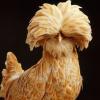Well worth signing up a free account for a few well researched monographs of Ayurvedic herbs:
http://www.toddcalde.../learning-herbsDoes it affect GABA levels or is it a GABA agonist?
Contraindications: A water-soluble fraction of Centella asiatica was reported to inhibit hepatic enzymes responsible for barbiturate metabolism (Leung and Foster 1996), and has been found to have a GABAnergic activity (Chatterjee et al 1992). Mandukaparni is thus contraindicated with the concurrent use of drugs such as benzodiazepines, barbituates or antiepileptics. Contact dermatitis has been reported in some clients using preparations of fresh or dried parts of the plant (Eun and Lee 1985). Although the triterpene constituents have shown to lack any kind or teratogenic effects (Bosse et al 1979), relaxation of the rat uterus has been documented for brahmoside and brahminoside, and therefore Mandukaparni is thus avoided in pregnancy (Ramaswamy et al 1970). Hyperglycemic and hypercholesterolemic effects have been reported for asiaticoside in humans (Newall et al 1996), and caution should be exercised with the concomitant use of hypolipidemic and hypoglycemic therapies. Frawley and Lad report high doses of Mandukaparni may cause a loss of consciousness and headaches, and that it may aggravate pruritis (1986, 171). The majority of Ayurvedic texts suggest that Mandukaparni is contraindicated in Vataja conditions (Warrier et al 1995, 54-55).
What else does it do?
Indications: Gastric ulceration and inflammation, dysentery, jaundice, hepatitis, fever, bronchitis, alopecia, eczema, psoriasis, leprous ulcers, venereal diseases, burns, anxiety, poor memory, ADD/ADHD, senility, Alzheimer’s disease, epilepsy, chronic fatigue, premature aging, hypertension, anemia, diabetes, edema, varicosities, phlebitis, venous insufficiency, immunodeficiency, autoimmune disorders, cancer.
Medicinal uses: Mandukaparni is a common green vegetable throughout Southeast Asia, from India to the Phillipines, sometimes eaten raw as a side dish, or prepared as a juice. It is said to be a favourite food of elephants in Sri Lanka. Modern clinical research has supported many of the time-honoured properties attributed to Mandukaparni. Plant geneticists have recently termed Mandukaparni as an “Araliaceous hydrocotyloid,” for although it is a member of the Apiaceae, it bears many similarities both botanically and in therapeutic action with other genera of the Araliaceae, such as Panax. For internal administration the fresh plant is considered best, either as a juice, or more recently, as a fresh plant tincture. Dried plant preparations howeve are used in Ayurveda and should not be considered as useless, but care should be taken to carefully source the herb, as Mandukaparni grows quite well along the edges of rivers and sewer outfalls and could be contaminated with heavy metals, fecal coliform or parasites. Mandukaparni is a useful treatment in a range of mental and cerebrovascular conditions including epilepsy, stroke, dementia, memory loss, poor concentration, and attention deficit disorder. Some texts state that Mandukaparni is the same as Brahmi (Bacopa monniera) in action, some even suggesting that they are even one and the same. They are however different plants with a different range of activities, but both are active as agents to enhance mental function. Generally speaking, Mandukaparni is used in cognitive dysfunction where Pitta is the predominant dosha, best used as the fresh juice, 25 mL twice daily. In skin conditions such as psoriasis and eczema benefit can be obtained by using Mandukaparni with hepatics such as Bhringaraja, Manjishta, Daruharidra (Berberis aristata) and Yellowdock (Rumex crispus). Mandukaparni may also be used topically in salves and balms to treat chapped lips, herpetic lesions, leprosy, scrofula, seborrheic dermatitis, 'dish pan' hands, eczema, psoriasis and insect bites and stings. As an alternative to antibiotics, Mandukaparni could be taken internally with Katuka and Bhunimba, or Western herbs such as Goldenseal (Hydrastis canadensis. root) and Purple Coneflower (Echinacea spp.) in the treatment of infectious conditions. For wounds Mandukaparni can be combined with Manjishta, Comfrey (Symphytum officinalis root), applied topically and taken internally to speed healing and recovery. A topical extract of Centella asiatica was found to be useful in Pseudofolliculitis barbae (razor bumps) when used as a shaving lubricant (Spencer 1985). Mandukaparni, along with other immunomodulants such as Huang qi (Astragalus membranaceus) and Ashwagandha (Withania somnifera root), should be considered an adjunct in the treatment of immunodeficiency diseases. The Ashtanga Hrdaya mentions the usefulness of Mandukaparni in the treatment of sannipataja udara (abdominal enlargement in which all three doshas are active), after purgative therapies have been initiated, taken as the fresh juice for a period of a month (Srikanthamurthy 1995, 438).
Is it safe to take in the long term?
Toxicity: No relevant data found.















































